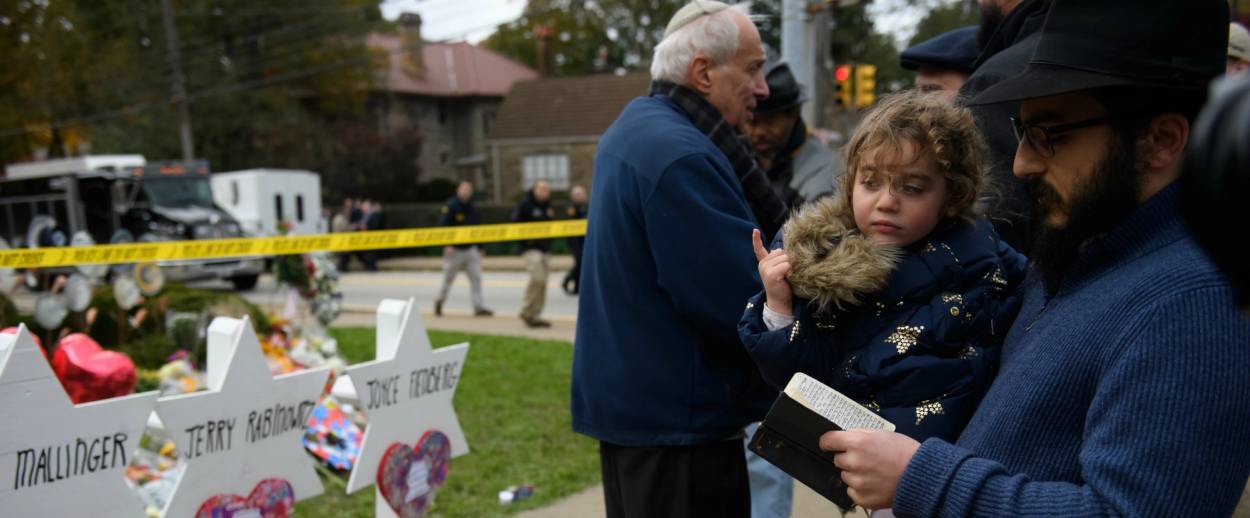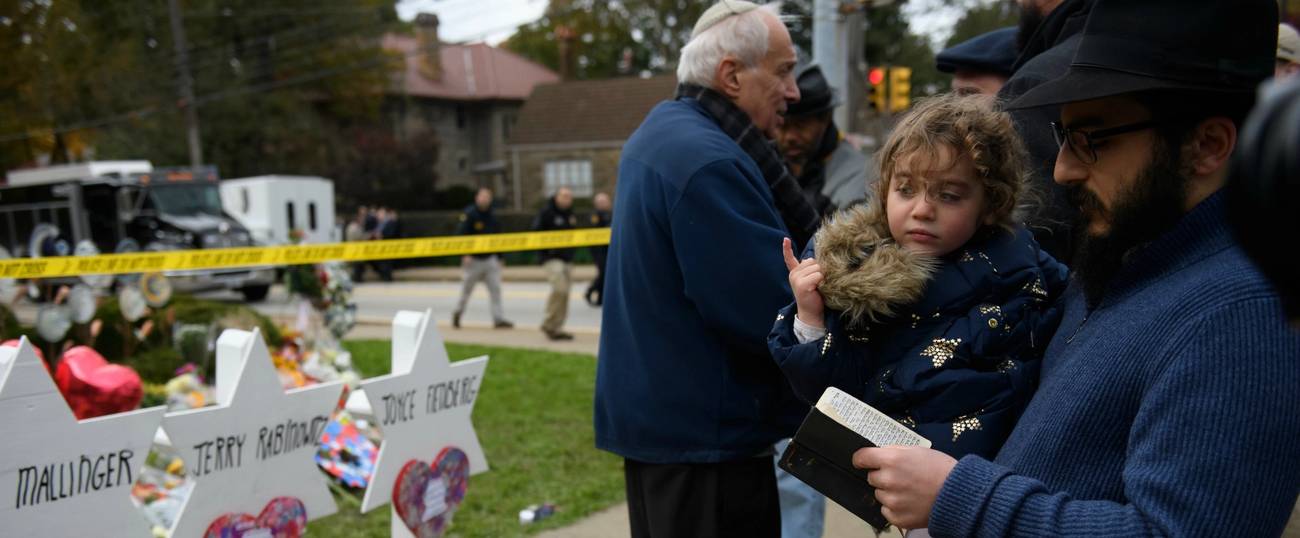What Happened in Squirrel Hill?
As the gunman turned toward the back of the room, and shot seven of the eight people unable to escape, the rabbi was able to get everyone in the front of the shul’s chapel out of the building




Shacharit began around 9:45 a.m. on Saturday morning at the Tree of Life. The shooting started not long after. According to Rabbi Jeffrey Myers, who described the scene in his speech at yesterday’s vigil, most of his early-arriving congregants tended to sit at the back of the prayer space. This included one man who was often stationed in a chair behind the rows of pews, and who served as the congregation’s unofficial greeter, wishing a good shabbos to everyone as they arrived. He was shot by the gunman, possibly first.
As the gunman turned towards the back of the room, and shot seven of the eight people unable to escape, Myers was able to get everyone in the front of the shul’s chapel out of the building. That moment was captured by a photographer. The cover of Sunday’s Pittsburgh Post-Gazette showed a photo of Myers still in his tallis, clutching his kippa to his head, appearing to nearly collide with a police officer who held a gun in his right hand.
The interior of the synagogue is almost unimaginable, even two days later: A “bloodbath,” as one person described it. Tree of Life has three prayer spaces, all of which are used on a typical Shabbat morning. There is a social hall on the same level as the main entrance that is often used for religious services. A short stairway leads to a side chapel and the main sanctuary.
Members of all three congregations that share the Tree of Life were killed. Reports indicate that victims were murdered in multiple parts of the building, including the social hall and the kitchen. The Aron Kodesh in the chapel, which has two layers of shelving accommodating 12 Torah scrolls, was also riddled with gunfire during the assault.
* * *
Shortly after 2 p.m. today, Tree of Life Rabbi Jeffrey Myers emerged from his synagogue carrying a single Torah scroll. Myers wore a black coat and a curved Hasidic-style hat; the Torah cover had a cubist pattern of bright oranges and yellows. Television cameras faced the rabbi. Behind him walked Rabbi Daniel Wasserman of the Orthodox Share Torah synagogue along with a half-dozen members of the Mesaskim and Chesed Shel Emes, teams of Orthodox Jews, mostly from the New York area, who will remove blood and human remains from the chapel, the sanctuary, and other parts of the synagogue building.
What was it like to return to the synagogue? one journalist asked Myers. “Very painful,” the rabbi replied. “I know where everyone was sitting.”
Rabbi Wasserman has also been inside the Tree of Life since the Saturday morning massacre. He, Rabbi Myers, and perhaps the Pittsburgh representative of the search and rescue organization Zaka, appear to be the only members of the city’s Jewish community who have set foot in the building.
Wasserman would not discuss what he had seen there. “Maybe next week. I haven’t time to process,” he told me. “And when I do process I don’t know what I’ll be able to process. I don’t have the luxury right now of thinking about it.”
Access to the first of several areas where congregants were murdered will likely be granted to the Mesaskim and Chesed Shel Emes tomorrow morning. Members of the two groups, which handle the removal of human remains in accordance with Jewish law, have been steely and professional. West Coast Chesed Shel Emes coordinator Rabbi Benjy Spiro, who has been in constant contact with the team in Pittsburgh, says they expect to be there for several days. He noted that every member of the organization is an unpaid volunteer.
The Torah was then loaded into the back seat of Rabbi Wasserman’s car. It was undamaged. According to Rabbi Myers, none of the Torahs in the Aron Kodesh were damaged, which might be described, by someone who wasn’t there, as a miracle. This particular scroll was being removed so that the FBI “could continue with the investigation,” Myers said.
The current state of the building apparently made it impossible to store all of the synagogue’s Torah scrolls there. Another, more hopeful reason for the Torah’s removal was raised to me by another Pittsburgh rabbi: “[The congregation] is going to meet somewhere this weekend and they need one of their Torahs.”
There won’t be services at the Tree of Life this coming Shabbat. The shul is a closed crime scene, which can only be sanitized once the investigation is complete. Until then, there will be an unspannable psychic and physical distance separating the makeshift shrine at Shady Avenue—piles of flowers and 11 Stars of David underneath thick stained glass windows that block out all view of the sanctuary inside—and the site of the massacre itself.
“I don’t think until we go back into the synagogue that it’ll really hit home,” said Ina Sable, an older Tree of Life member and everyday synagogue-goer. The victims, she added, were “friends to everyone. It doesn’t make sense. You see the people one day, and the next day they’re not here.”
* * *
Things move quickly in the aftermath of a communal tragedy, faster than anyone’s ability to process what happened. Yesterday was the city-wide memorial vigil; the funerals begin tomorrow, when President Donald Trump is expected to visit Pittsburgh.
Myers has said that he wouldn’t oppose Trump’s presence, telling CNN that “the president is always welcome,” though some activist groups and other communal leaders have urged the president to stay away. In his speech at yesterday’s vigil, Myers said that “words of hate are unwelcome in Pittsburgh” but then emphasized that he was not speaking about any one individual or political bloc. “My words are addressed at all political leaders: Stop the words of hate … if it comes from you, Americans will listen.”
Later on Monday afternoon, dozens of students from the nearby yeshiva girls high school davened mincha in front of the synagogue. They closed the service singing the words of Rabbi Nachman of Breslov in Hebrew: “The whole world is a narrow bridge, and the important thing is not to fear.”
When the boys finished doing shemona esrei at a service that took place about a half-hour later, they raised their heads to see Pittsburgh Mayor Bill Peduto standing eye-to-eye facing them, just feet away. He promised their yeshiva would remain safe; moments later, in front of the mayor and several police officers, New York Rabbi Avi Weiss recited a psalm in honor of the four policemen who were shot on Saturday subduing the shooter.
There has never been a synagogue attack of this scale in the United States before, and therefore no real communal template for the aftermath of such an atrocity. Every scene that emerges from Pittsburgh is something that’s never been witnessed in America before. “These things don’t happen in Squirrel Hill,” Wasserman said. “Oh wait, they happen in Squirrel Hill. I don’t know what it means. It’s like an out-of-body experience watching this.”
Armin Rosen is a staff writer for Tablet Magazine.